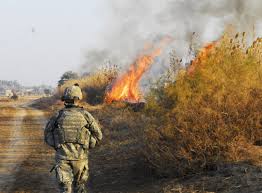David Trend
“Confessions of a Drone Warrior,” is one of hundreds of articles on the military’s use of Unmanned Ariel Vehicles (UAV), which began in the early 2000s. In many ways this new form of combat embodies the psychological distancing that typifies killing in the twenty-first century. The story about Airman First Class Brandon Bryant recounts his first day in a Nevada bunker, when the 22-year fired on two presumed Afghani insurgents on the other side of the world. An early recruit in this new kind of warfare, Bryant “hunted top terrorists, but always from afar” –– killing enemies in countless numbers, but not always sure what he was hitting. “Meet the 21stcentury American killing machine,” the story concluded.[i]

Of course, notions of aversion to fighting don’t sit well with either military doctrine or public belief. Behind America’s infatuation with high-tech weapons lie long-cultivated attitudes toward violence itself. In a class I teach on this, students often will express common sense views that fighting is “natural,” deriving from humanity’s animalistic origins, and often the only way of resolving conflicts. One sees this kind of thinking evident in permissive attitudes toward everything from boyish rough-housing to violent sports. The gendered aspects of violence receive less attention than they should, and will be addressed at length in Chapter 9. Suffice to say that aggression often is expected of men and boys, while also reflected in popular culture. Along with political partisanship, these attitudes help explain the deep divisions within the U.S. electorate over gun control and so-called “stand your ground” laws. Since even scholars often disagree over the issue of human violence, it helps to break the question into subcategories –– and to also point out how knowledge has changed over time in the fields of biology, psychology, and cultural analyses of violent behavior.
Continue reading “Natural Born Killers?”
 During this same time period, Washington, DC has been consumed by a government shutdown, with lawmakers and policymakers trying to determine how to rein in our country’s financial burdens and overspending. Unfortunately, as federal and state governments look to cut budgets at every turn, mental and behavioral health services are often on the chopping block first. Financial cuts, compounded with US stigma often applied to mental health troubles and disparate access to services across the county, mean that those who need services most are often those left without proper care.
During this same time period, Washington, DC has been consumed by a government shutdown, with lawmakers and policymakers trying to determine how to rein in our country’s financial burdens and overspending. Unfortunately, as federal and state governments look to cut budgets at every turn, mental and behavioral health services are often on the chopping block first. Financial cuts, compounded with US stigma often applied to mental health troubles and disparate access to services across the county, mean that those who need services most are often those left without proper care.












